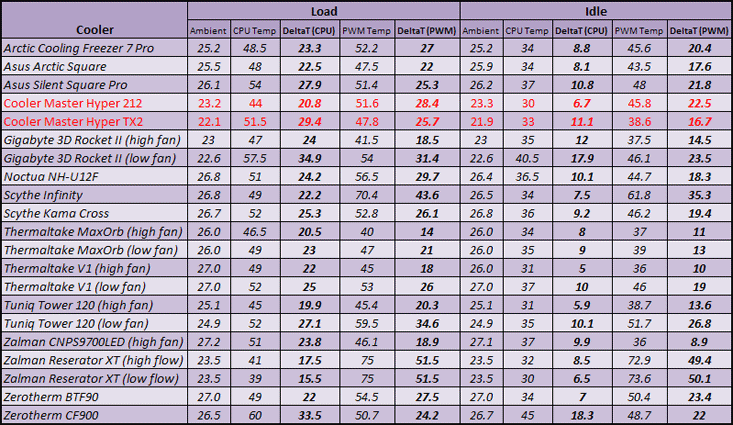Cooler Master Hyper TX2 & 212
November 19, 2007 | 11:20
Companies: #amd #coolermaster #cooler-master #intel

Results
At full pelt the Cooler Master Hyper TX2 is about as noisy as the Arctic Cooling Freezer 7 Pro is at full load: audible but not offensively noisy. It's the same situation with the Hyper 212 as well: reasonably quiet depending on your tolerance, certainly audible but not offensive.On our mainstream MSI P6N SLI board with 4-pin connector, the Freezer 7 Pro works with the fan control software but the Hyper TX2 doesn't because it only uses a 3-pin fan header. Since Cooler Master doesn't supply any fan control in the box we simply ran it at the speed it was designed to do at 2,000RPM.
The Hyper 212 performance was very good, coming high up our list in temperature difference (Delta T) values, in and around that of Tuniq Tower 120, Thermaltake MaxOrb, V1 and Zerotherm BTF90. It's of appreciable volume to the Thermaltake at this speed too, but has far less mechanical fan noise (as opposed to air noise) than the Tuniq.
Personally I'd have to knock the fan down a bit in order to live with it for long periods, so you're looking at about mid table along the lines of the Noctua to have the best compromise between noise to performance. The PWM temperatures are certainly good, lower than the Noctua as well, and the idle temperatures are among the lowest we've seen. However the Hyper TX2 PWM values are even better thanks to its dedicated plastic shroud angling the air downwards onto the heatpipes.
The results difference between the Freezer 7 Pro and Hyper TX2 is surprisingly large though, to the point where we retested the Freezer 7 Pro to check the reproducible accuracy and confirm our sanity. Our PWM readings were reproducible within 0.1 degrees and the DeltaT values were within a single degree as well. In this respect there's a large six degree difference between the Freezer 7 Pro and TX2, which we can only suggest is due to the increased fin surface area and fin density you get with the Freezer 7 Pro. They both have three heatpipes and copper bases with similarly sized fans.
Incidentally the rubber grommets on the Freezer 7 Pro work exceptionally well and completely isolate the little vibration there is. In comparison the Hyper TX2 doesn't offer the same facility, although it's a hardly going to shake your case apart when you have bits like 7,200RPM hard drives whizzing away.

MSI MPG Velox 100R Chassis Review
October 14 2021 | 15:04









Want to comment? Please log in.